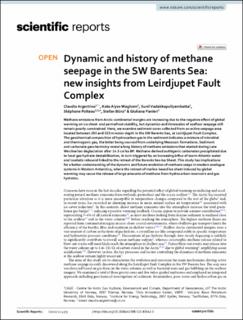Dynamic and history of methane seepage in the SW Barents Sea: new insights from Leirdjupet Fault Complex
Argentino, Claudio; Waghorn, Kate Alyse; Vadakkepuliyambatta, Sunil; Polteau, Stephane; Bünz, Stefan; Panieri, Giuliana
Peer reviewed, Journal article
Published version

View/
Date
2021Metadata
Show full item recordCollections
Original version
10.1038/s41598-021-83542-0Abstract
Methane emissions from Arctic continental margins are increasing due to the negative effect of global warming on ice sheet and permafrost stability, but dynamics and timescales of seafloor seepage still remain poorly constrained. Here, we examine sediment cores collected from an active seepage area located between 295 and 353 m water depth in the SW Barents Sea, at Leirdjupet Fault Complex. The geochemical composition of hydrocarbon gas in the sediment indicates a mixture of microbial and thermogenic gas, the latter being sourced from underlying Mesozoic formations. Sediment and carbonate geochemistry reveal a long history of methane emissions that started during Late Weichselian deglaciation after 14.5 cal ka BP. Methane-derived authigenic carbonates precipitated due to local gas hydrate destabilization, in turn triggered by an increasing influx of warm Atlantic water and isostatic rebound linked to the retreat of the Barents Sea Ice Sheet. This study has implications for a better understanding of the dynamic and future evolution of methane seeps in modern analogue systems in Western Antarctica, where the retreat of marine-based ice sheet induced by global warming may cause the release of large amounts of methane from hydrocarbon reservoirs and gas hydrates.
